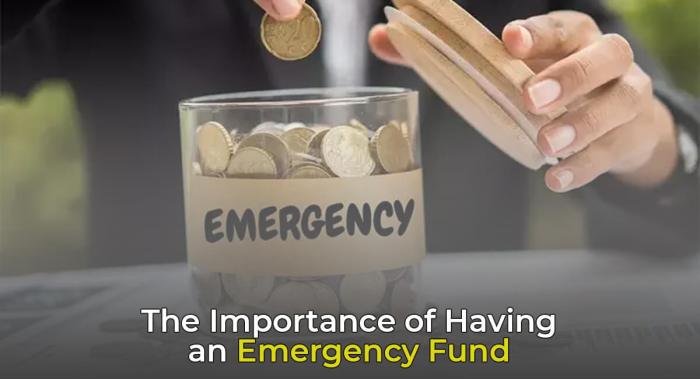Yo, let’s talk about the real deal – the Importance of an emergency fund. This is not just about saving money, it’s about securing your financial future and being prepared for whatever life throws your way. So buckle up and let’s dive in!
From sharing real-life stories to discussing strategies, we’re about to break it down for you in a way that’s totally relatable and easy to understand.
Importance of an emergency fund
In today’s unpredictable world, having an emergency fund is not just a good idea, but a critical component for achieving financial stability.
Financial Stability
An emergency fund serves as a safety net during unexpected events like job loss, medical emergencies, or car repairs. Without this fund, individuals may resort to taking on high-interest debt, which can lead to financial strain and long-term consequences.
Real-life Examples
Consider a situation where a family member suddenly falls ill and requires immediate medical attention. Having an emergency fund can cover the medical expenses without disrupting the family’s financial goals or causing additional stress during an already challenging time.
Peace of Mind
Knowing that you have a financial cushion in place can provide peace of mind in the face of uncertainty. Whether it’s a natural disaster, unexpected home repairs, or a sudden loss of income, having an emergency fund allows you to navigate these situations without compromising your financial well-being.
Building an emergency fund
Building an emergency fund is crucial for financial stability and peace of mind. It involves setting aside a specific amount of money to cover unexpected expenses that may arise.
Steps to set up an emergency fund
- Determine your monthly expenses: Calculate your average monthly expenses, including bills, groceries, and other necessities.
- Set a savings goal: Aim to save at least 3 to 6 months’ worth of expenses in your emergency fund.
- Create a separate account: Open a separate savings account specifically for your emergency fund to avoid spending it on non-emergencies.
- Automate your savings: Set up automatic transfers from your checking account to your emergency fund to ensure consistent savings.
- Regularly review and adjust: Reassess your savings goal and contributions periodically to account for any changes in your financial situation.
Ideal amount to save in an emergency fund
- Financial experts recommend saving between 3 to 6 months’ worth of living expenses in an emergency fund.
- Consider factors such as job stability, health issues, and dependents when determining the ideal amount to save.
- Adjust your savings goal based on your individual circumstances and comfort level.
Savings vehicles for an emergency fund
- Savings account: Offers easy access to funds but may have lower interest rates compared to other options.
- Money market account: Provides higher interest rates than a traditional savings account while still allowing easy access to funds.
- Certificate of Deposit (CD): Offers higher interest rates but requires locking in funds for a specific term, limiting access in case of emergencies.
Using an emergency fund

In times of unexpected financial hardships, having an emergency fund can be a lifesaver. However, it is crucial to use this fund wisely to ensure long-term financial stability.
When to use funds from an emergency fund
- Medical emergencies: Use your emergency fund to cover unexpected medical expenses that are not fully covered by insurance.
- Job loss: If you suddenly lose your job, use the fund to cover essential living expenses until you find a new source of income.
- Car or home repairs: When faced with unforeseen repairs, tapping into your emergency fund can help you avoid going into debt.
Tips for replenishing an emergency fund
- Set a realistic budget: Review your expenses and prioritize saving a portion of your income to replenish the fund.
- Automate savings: Set up automatic transfers to your emergency fund each month to ensure consistent contributions.
- Reduce non-essential spending: Cut back on unnecessary expenses to free up more money for your emergency fund.
Impact of using an emergency fund on long-term financial goals
Using your emergency fund for unexpected expenses can temporarily slow down progress towards long-term financial goals, such as saving for retirement or buying a home. However, having this safety net in place can prevent you from going into debt and derailing your financial future.
Emergency fund vs. other savings
An emergency fund is not the same as other types of savings, such as retirement savings or investment accounts. It serves a specific purpose and should be kept separate from regular savings for various reasons.
Having a separate emergency fund ensures that you have a financial safety net in case of unexpected expenses, such as medical emergencies, car repairs, or job loss. Unlike retirement savings or investment accounts, which are meant for long-term goals, an emergency fund is easily accessible and liquid, allowing you to cover immediate financial needs without having to dip into your long-term savings.
Benefits of an emergency fund over other savings
- An emergency fund provides peace of mind and financial security during unforeseen circumstances, while retirement savings and investment accounts are intended for future goals.
- Unlike retirement savings, which may come with penalties for early withdrawal, an emergency fund can be accessed at any time without restrictions.
- In situations like unexpected medical bills or sudden home repairs, having an emergency fund can prevent you from going into debt or selling investments prematurely.
